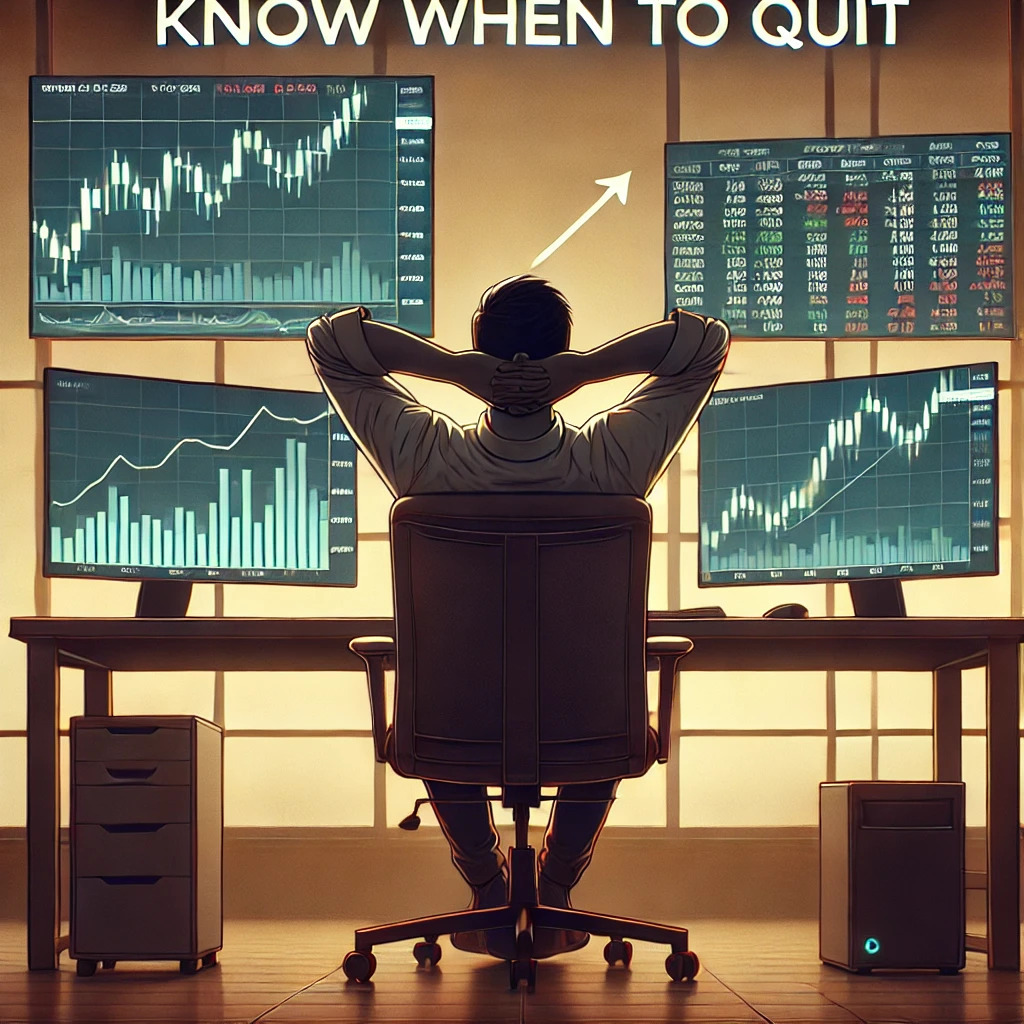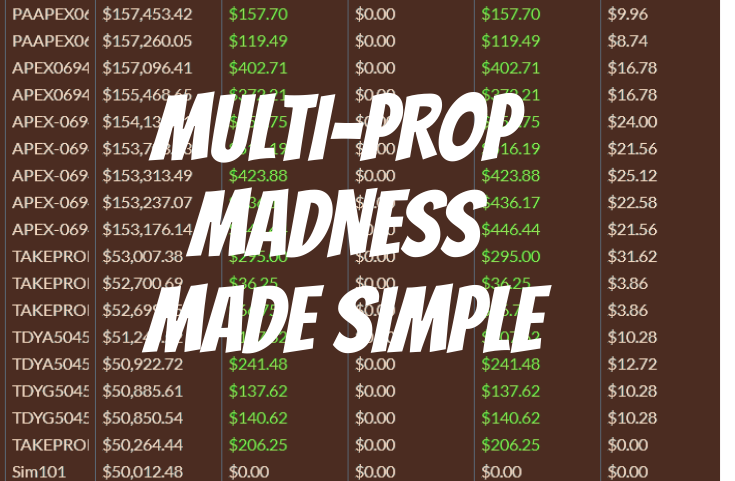The Power of Quitting: How and When to Walk Away on a Winning Day
Ever found yourself on a winning streak in the markets and thought, “Maybe I should keep going and see how far I can take this?” Well, if you’ve traded long enough, you know that staying in the game too long can sometimes end in regret. Welcome to The Power of Quitting, a guide on knowing when to close your trading day, especially when you’re ahead.
We even recorded a podcast episode diving deeper into this topic—if you prefer a chat-style approach, check that out!
Why Quitting Matters, Especially When You’re Up (An AI Podcast)
Let’s start with the simple stuff: when your Daily Risk Budget (DRB) is hit on a losing day, you stop—no questions, no second guesses. But on winning days, the line isn’t so clear. Knowing when to lock in gains without falling into the “one more trade” trap can be a game-changer for both your profits and emotional energy. Here are a few tried-and-true steps to make quitting on a high note part of your trading routine.
Step 1: Hitting DRB? Quit the First Few Times
If you’re just starting with quitting discipline, consider quitting the first few times you hit or slightly exceed your DRB. Think of it as training—just because you’re winning doesn’t mean you have to keep trading. Quitting at your DRB allows you to build confidence in your strategy and get used to ending a session on your terms.
Step 2: Stick to Your Usual Trading Hours
Most of us trade best within a certain timeframe. Maybe that’s 90 minutes from the NY open. Extending your screen time when you’re up might seem tempting, but it can wear you down and lead to unnecessary losses. Quitting while you’re still fresh helps keep your performance consistent, so resist the urge to break routine just because you’re ahead.
Step 3: Take an Honest Look at How You Made Your Profit
Before deciding to continue, ask yourself how the profit was achieved. Was it a single, lucky trade? If so, that’s a pretty good cue to call it a day. Or was it steady performance—like five or more trades with an 80% win rate and similar-sized wins? If so, that’s a signal of flow, indicating that both the market and your execution were on point. Use this checklist to decide if the market’s still in your favor:
- Was there consistent, reliable performance across trades?
- Were trades aligned with your main strategy (like “Stay In Your Lane”)?
- Were wins around the same size, suggesting steady execution?
If the answer is a strong “yes” on most counts, then a few more trades might be worth it.
Step 4: Raise Entry Criteria & Lower Position Size
If you do decide to continue, make trades only on top-tier setups. Think about waiting until the second standard deviation from VWAP or dropping your position size from two contracts to one. This approach narrows your exposure and ensures that only high-probability setups tempt you to stay in.
Step 5: Use a Secondary DRB as Your Quit Point
When continuing, set a secondary DRB to prevent big givebacks. This might be 25% of the session profit or limited to 1-2 more trades. If these trades aren’t profitable, or if they require a “graceful exit” (where you scratch or close a trade on a minor retracement), then it’s time to quit the session entirely.
Step 6: Track Flow State Using VWAP Volatility Bands
A steady flow state is crucial to profitable days. For mean-reversion strategies, flow state often shows up when price respects VWAP bands—consistently bouncing back to VWAP from standard deviation extremes. If this pattern changes or price starts breaking through VWAP without reverting, it’s time to pack up for the day.
Step 7: Keep a Journal to Refine Your Quitting Decisions
Nothing helps fine-tune your instincts like a good journal. Tracking not just your trades but your mindset can reveal patterns about when it’s best to stop for the day. For instance, note if you were in a flow state, what factors led to continued trading, and how market conditions aligned with your strategy. Reflecting on why you quit—or chose to continue—will only make this framework stronger.
Step 8: Commit Fully to Quitting (Avoid the Demo Trap)
Resist switching to a demo account after a profitable day. Demo trading has different emotional stakes, which can lead to bad habits when you go back to live trades. Instead, quit completely, knowing you protected your gains.
A Note on Fatigue
Remember, trading is mentally and physically demanding. If you’re tired, the best call is often to quit, secure your profit, and rest up for the next session. Running on fumes can lead to sloppy trades and lost gains.
Closing Thoughts: Make Quitting Your Power Move
Ultimately, quitting while ahead is a discipline. By creating a framework and journaling each day, you make quitting a valuable skill. If you’re interested in hearing more, don’t forget to check out our podcast episode above, where we explore these ideas with real-world examples and a few stories from the ai trading floor!
Commodity Futures Trading Commission. Futures and Options trading has large potential rewards, but also large potential risk. You must be aware of the risks and be willing to accept them in order to invest in the futures and options markets. Don’t trade with money you can’t afford to lose. This is neither a solicitation nor an offer to Buy/Sell futures or options. No representation is being made that any account will or is likely to achieve profits or losses similar to those discussed on this web site. The past performance of any trading system or methodology is not necessarily indicative of future results.
CFTC RULE 4.41 – HYPOTHETICAL OR SIMULATED PERFORMANCE RESULTS HAVE CERTAIN LIMITATIONS. UNLIKE AN ACTUAL PERFORMANCE RECORD, SIMULATED RESULTS DO NOT REPRESENT ACTUAL TRADING. ALSO, SINCE THE TRADES HAVE NOT BEEN EXECUTED, THE RESULTS MAY HAVE UNDER-OR-OVER COMPENSATED FOR THE IMPACT, IF ANY, OF CERTAIN MARKET FACTORS, SUCH AS LACK OF LIQUIDITY. SIMULATED TRADING PROGRAMS IN GENERAL ARE ALSO SUBJECT TO THE FACT THAT THEY ARE DESIGNED WITH THE BENEFIT OF HINDSIGHT. NO REPRESENTATION IS BEING MADE THAT ANY ACCOUNT WILL OR IS LIKELY TO ACHIEVE PROFIT OR LOSSES SIMILAR TO THOSE SHOWN.











